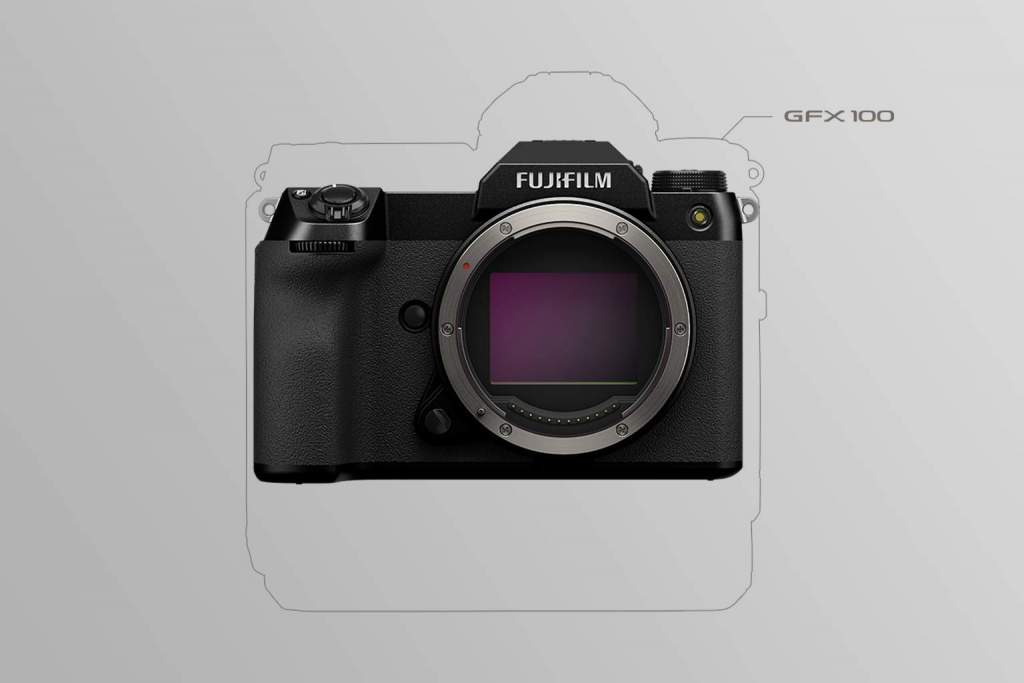The GFX100S is Fujifilm’s latest medium format mirrorless camera, a follow-up to their popular 2019 release, the GFX100. We recently had the opportunity to try out the new camera, which started shipping this week. Here’s our Fujifilm GFX100S review.
When the GFX100S was announced earlier this year, the technical specifications revealed it shares the same sensor and image processor as the GFX100. However, there were also several upgrades that immediately caught our eye. Namely, a lighter, more compact build and a significantly lower price tag. To read more about how the new camera compares to its predecessor, check out our GFX100S vs GFX100 comparison post.
As a medium format camera, the GFX100S is ideal for studio use. So, we decided to set up a mock still life photography shoot inside our studio and put the new camera to the test.
Build

The GFX100S is remarkably smaller and lighter than most medium format cameras. The camera weighs 31.7oz (900g) when loaded with a battery and memory card, and measures approximately 5.9 x 4.1 x 3.4 inches. For comparison, the GFX100 weighs 49.4 oz (1,400g) and measures 6.15 x 6.44 x 4.05 inches when fitted with its detachable EVF.
In fact, the build of the GFX100S generally feels closer to a full frame camera than a medium format model. New features include a built-in EVF, a more ergonomic, contoured hand grip, a PASM dial with six customizable positions, and a switch for toggling between stills and video recording. Additionally, the focus lever on the back of the camera has been updated, along with the internal firmware, to make it easier to select the right focus point. The camera also has two UHS-II SD card slots and uses a single NP-W235 battery, the same used by the X-T4.
Another reason the GFX100S is more compact than the previous model is its updated, 5 axis in-body image stabilization system. The new IBIS is 20% smaller than the system used in the GFX100 and offers up to 6 stops of compensation (instead of 5.5 on the GFX100).
The GFX100S is still stocky in comparison to powerful full frame competitors like the Sony a1 and Canon EOS R5. It’s about 5.75oz (163g) heavier, and a little larger than both models. However, that’s perhaps an unfair comparison given the GFX100S is equipped with a larger, higher resolution sensor.
Overall, the GFX100S is an impressively built camera that incorporates the ergonomic and user-friendly design features of a full frame camera while housing the powerful components of a medium format model.
Performance
The GFX100S uses a 102MP BSI-CMOS 1.7 x 1.3’’ sensor and quad-core image processor, enabling it to capture truly breathtaking visuals. The dynamic range is outstanding, resulting in an incredible level of detail in every image. Using the camera’s Pixel Shift Multi-Shot function, which combines 16 RAW files to create a single image, you can even capture a photo with a 400MP resolution.
Of course, these capabilities are consistent with the previous model. What makes the GFX100S special is how it exceeds the expectations of the GFX100 and all other medium format models.
Firstly, the new compact build and enhanced IBIS compensation makes it a lot easier to operate handheld. Sure, it’s a little heavy to carry around outside for hours on end, but it’s perfect for use inside a studio. Using the add-on metal hand grip also makes it more comfortable to handle.
Additionally, the video capabilities of the new camera are stunning. You can shoot DCI 4K video at up to 30p 4:2:0 10-bit internally, or up to 4:2:2 10-bit externally via HDMI. 10-bit F-Log or Hybrid Gamma Log (HLG) profiles are also supported internally, or 12-bit ProRes RAW externally. There are medium format cameras four times the price of the GFX100S that don’t support any kind of video recording, let alone able to shoot cinema-grade 4K footage.
The autofocus algorithm for movement tracking and face and eye detection has also been updated and improved for the GFX100S. While we primarily shot a still life set, it was clear the camera would also be a great choice for portraiture. Especially if pairing the camera with Fujifilm’s new 80mm F1.7 R WR lens.
Another cool feature is the addition of a new Film Simulation mode, Nostalgic Neg, which automatically applies a saturated, soft-toned color grade for stills and video.
Price
The GFX100S is available for pre-order now for $5,999.95. That makes it significantly more affordable than the GFX100 ($9,999), and slightly more affordable than the Sony a1 ($6,498). Given the camera’s impressive build and performance capabilities, this is an incredible price.
The Verdict
Concluding our Fujifilm GFX100S review, it’s clear the GFX100S is an incredible camera. High powered, easy to handle, and competitively priced, it’s already one of the best camera models released this year. If you’re in the market for a new, ultra-high resolution camera, the GFX100S is a fantastic choice.

















